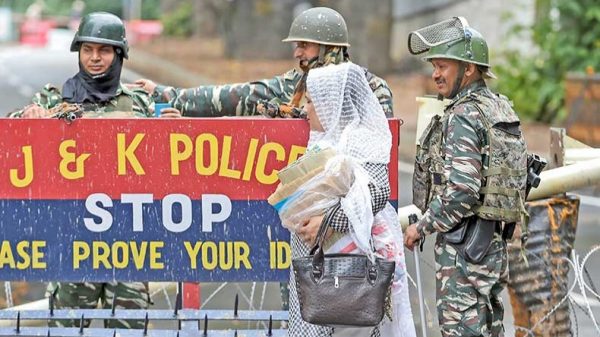Kashmir: the lull before storm?

INDIA’S frantic search for a solution to the Kashmir crunch has enabled uts policy planners to realise their need and also to understand this better. Indeed, there exist deadly perils in jumping to solutions without first understanding the gruesome reality. Only quacks, or maybe faith-healers, may be expected to prescribe cure for chronic ailments without arriving at a rational diagnosis.
And in the context of the Kashmir dilemma, we still continue to rely on faith-healers. In doing so, we may be exposed to three sets of solutions to be made available by three categories of ‘faith-healers’. First, in India, the establishment’s view has always mattered which finds a wide popular support in the conviction that Pakistan has remained embedded with the Kashmir dilemma and has continued to export ‘radical Islam’ across the borders, accompanied by rifles, rocket-launchers and RDX.
Simply get the Pakistanis off the backs of India and you will smile like the film shooting of an extended sequel to the popular movie Kashmir Ki Kali in Dal Lake.
On the other side of the turbulent border, the Pakistani establishment is enriched in its own brand of fantasy, with a wide public support that is just the exact opposite: get the Indians out by pushing, pinching and bleeding them. We defeated Soviets and Americans in Afghanistan. Why can India not be shamed by defeat? This obviously will integrate all of Kashmir as the fifth province of Pakistan.
The third category comes by way of expert analysis today from India’s small yet doughty group of liberals who accept that Kashmir’s accession to India is not final. The franchised will of the Kashmiris is paramount and it has not yet been sought. To that extent, their basic demands for plebiscite, autonomy and even independence are legitimate. You just cannot keep them with India by using state and military power. Pakistan failed miserably in East Bengal, which transformed in Bangladesh in a short span.
Rationally so, it is difficult to argue with this: India is a voluntary federation of states. So how can you force people to stay with you if they do not want it? No surprise that this view also finds sympathy among a lot of fundamentally liberal and young elite. I understand the perils in picking an argument with them because this very position gives them a higher moral ground. But then, all of India including Jammu and Kashmir live very dangerously.
Let us decompose the story into ground realities, down to five fundamental pillars on which this current liberal position rests:
— India made a commitment to a plebiscite in the United Nations Security Council Resolutions of 1947–48. Why did it go back from the promises?
The fact is, both India and Pakistan made this commitment. And they both failed miserably in upholding these. If you read the text of the resolution (47), however, you will see a three-step ladder. The first was Pakistan withdrawing all its forces from Kashmir and then making the ‘best endeavours’ to ensure all others (we will call them jihadis today) leave as well. It never happened.
The next two steps were India, thinning its troops to the minimum needed, setting up an all-party government and then for a plebiscite to be held under a UN-appointed governor. Pakistan did not take the first step. India was not jumping to take the next two.
— Most Kashmiris want neither India nor Pakistan. They want freedom or azaadi. How can you deny it to them? Think referendum, think Quebec, Scotland, or Brexit.
Once again, let us take time to read the resolutions. It will take you three minutes. They do not provide independence or azaadi as an option. The choice is India or Pakistan.
Pakistan’s supposed support for Kashmiri ‘azaadi’ is fraudulent, but it has also had some Goebbelsian (German propaganda) success with this great deception that Pakistanis back freedom for Kashmiris. Pakistan has built this masterfully over 70 years, calling the part of Kashmir occupied by it ‘Azad Kashmir’.
Since Pakistanis claim all of Kashmir, should they not be calling it their state of Jammu and Kashmir as well? No. Because that will expose their hypocrisy in using azaadi as a cover for territorial capture. Google if there are any statements from any Pakistani leaders of consequence offering azaadi as an option. I find none. If you buy into that azaadi fantasy, please do. You cannot sell it to the rest of India.
— Can you hold for ever a territory and people by military power?
The answer is another counter-question: Can you take away a territory and people from another country through military power? Pakistan made this error in 1971. Twice, in 1947–48 and 1965 through direct military invasion and 1989 onwards, with proxy war. There was also the little madness of Kargil 1999. These are facts.
You need to understand Nehru’s shift on the UN resolutions from mid-1953 onwards. The cold war was then ratcheting up and Kashmir’s geography trapped it into a unique pincer where the great game had not ended. Foreseeing trouble, he moved to integrate Kashmir in 1953 with Sheikh Abdullah’s arrest. In the next two years, Pakistan had joined the US-led Baghdad Pact, SEATO, etc.
It began tilting the military balance in its favour over the next decade. Ultimately, it was Nehru’s pre-emptive action that saved Kashmir from military (not plebiscite-led) capture.
Obviously, the Pakistanis waited until they felt they had built sufficient military advantage, caught India in a period of weakness — military recovering from the 1962 debacle, Nehru’s death, food shortage — and used its full US-armed and trained military might (read up on Op Gibraltar and Op Grand Slam) to take Kashmir, but failed.
This was the last time Pakistan could have taken Kashmir by direct military force. And it had not sent its troops and tanks to win Kashmiris’ azaadi.
These three pretty much account for the twists and turns in the Kashmir story in its first UN-to-Simla epoch (1947–72) at a kind of digital pace in fast-forward though. That brings us to the fourth:
— Why is the Modi government not settling Kashmir according to the Simla Agreement as even Imran Khan is now saying?
The answer again: kindly, read the text of the short Simla Agreement. The literal sense is all India-Pakistan problems are now bilateral, which means, no UN resolutions. The spirit was that the both realise that none can take any territory by force. So, rename the Cease Fire Line as the Line of Control and work on persuading your people to accept it as the border. Why was this not stated more explicitly is a brilliant subject for some genuine scholar for a book called ‘The Guilty Indians (not just men) of Simla’.
But the spirit was betrayed as soon as the prisoners of war returned. Zulfikar Ali Bhutto began Islamising his country (yes, he did, not Zia), hosted the Organisation of Islamic Conference summit in Lahore, even named its cricket stadium after Muammar Gaddafi as he launched a fund-raiser for his ‘Islamic bomb.’
The cool breeze of Simla lasted only until the bomb was ready. By 1989, Pakistan was back in ‘action’, trying to take Kashmir with force again, avoiding direct confrontation which it knew it would lose.
The Simla Agreement was, indeed, violated. Only by Pakistan.
— But the Kashmiris do not want to be with you, what can you do?
Again, a counter-question: Who are the Kashmiris? The right-nationalists are missing nuance when they say just 10 districts of the valley cannot speak for all of the state. Because these represent the state’s majority. The liberal argument is more flawed. If the majority view of valley Muslims then subsumes the sizeable minorities of the state, what do we do for the view of the rest, about 99.5 per cent of India? Can you have the democratic logic of majority work in one place and not in the other?
Whether you like Narendra Modi or not, he has now broken the post-Simla status quo. Pakistan’s space for sub-military manoeuvre is gone. No political party of consequence is questioning the abrogation of Article 370, only the method.
There is a new status quo now. Pakistan can risk breaking it. There is a problem in Kashmir, with anger, alienation, violence, human rights abuses, and it needs addressing. It must begin with accepting that the borders today are the permanent borders of India and Pakistan. We should not need Bill Clinton to come here and tell us that maps of the region can no longer be redrawn with blood. Once you accept this reality, you can argue about the future.
Are the parties involved ready to do so? If the answer is ‘no’, say bye-bye to peace in the region. Sorrowfully, the beautiful Kashmir valley will continue to haunt us as the world’s most dangerous flash point.























Leave a Reply